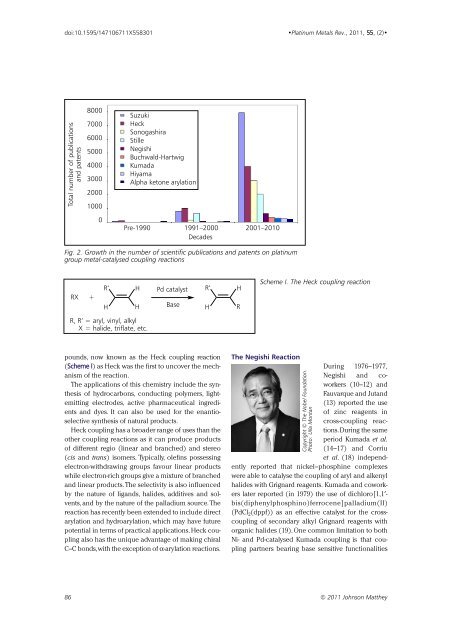Download - Platinum Metals Review
Download - Platinum Metals Review
Download - Platinum Metals Review
You also want an ePaper? Increase the reach of your titles
YUMPU automatically turns print PDFs into web optimized ePapers that Google loves.
doi:10.1595/147106711X558301<br />
•<strong>Platinum</strong> <strong>Metals</strong> Rev., 2011, 55, (2)•<br />
Total number of publications<br />
and patents<br />
8000<br />
7000<br />
6000<br />
5000<br />
4000<br />
3000<br />
2000<br />
1000<br />
0<br />
Suzuki<br />
Heck<br />
Sonogashira<br />
Stille<br />
Negishi<br />
Buchwald-Hartwig<br />
Kumada<br />
Hiyama<br />
Alpha ketone arylation<br />
Pre-1990 1991–2000 2001–2010<br />
Decades<br />
Fig. 2. Growth in the number of scientific publications and patents on platinum<br />
group metal-catalysed coupling reactions<br />
RX +<br />
R’ H<br />
H<br />
H<br />
Pd catalyst<br />
Base<br />
R’ H<br />
H<br />
R<br />
Scheme I. The Heck coupling reaction<br />
R, R’ = aryl, vinyl, alkyl<br />
X = halide, triflate, etc.<br />
pounds, now known as the Heck coupling reaction<br />
(Scheme I) as Heck was the first to uncover the mechanism<br />
of the reaction.<br />
The applications of this chemistry include the synthesis<br />
of hydrocarbons, conducting polymers, lightemitting<br />
electrodes, active pharmaceutical ingredients<br />
and dyes. It can also be used for the enantioselective<br />
synthesis of natural products.<br />
Heck coupling has a broader range of uses than the<br />
other coupling reactions as it can produce products<br />
of different regio (linear and branched) and stereo<br />
(cis and trans) isomers. Typically, olefins possessing<br />
electron-withdrawing groups favour linear products<br />
while electron-rich groups give a mixture of branched<br />
and linear products.The selectivity is also influenced<br />
by the nature of ligands, halides, additives and solvents,<br />
and by the nature of the palladium source.The<br />
reaction has recently been extended to include direct<br />
arylation and hydroarylation, which may have future<br />
potential in terms of practical applications. Heck coupling<br />
also has the unique advantage of making chiral<br />
C–C bonds,with the exception of α-arylation reactions.<br />
The Negishi Reaction<br />
Copyright © The Nobel Foundation.<br />
Photo: Ulla Montan<br />
During 1976–1977,<br />
Negishi and coworkers<br />
(10–12) and<br />
Fauvarque and Jutand<br />
(13) reported the use<br />
of zinc reagents in<br />
cross-coupling reactions.During<br />
the same<br />
period Kumada et al.<br />
(14–17) and Corriu<br />
et al. (18) independently<br />
reported that nickel–phosphine complexes<br />
were able to catalyse the coupling of aryl and alkenyl<br />
halides with Grignard reagents. Kumada and coworkers<br />
later reported (in 1979) the use of dichloro[1,1′-<br />
bis(diphenylphosphino)ferrocene]palladium(II)<br />
(PdCl 2 (dppf)) as an effective catalyst for the crosscoupling<br />
of secondary alkyl Grignard reagents with<br />
organic halides (19).One common limitation to both<br />
Ni- and Pd-catalysed Kumada coupling is that coupling<br />
partners bearing base sensitive functionalities<br />
86 © 2011 Johnson Matthey
















